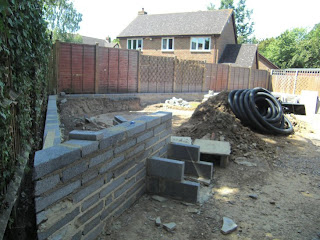Garden design is not about being able to create a beautifully illustrated plan, although this is one of the many outputs of the garden design process. A garden designer’s role is to find creative, practical solutions to the many technical challenges presented by an outdoor space. A good garden designer can make a garden that is useable and suitable for a specific set of requirements as well as being beautiful and a pleasure to spend time in.
It would not be possible to tell you how to design a garden in a single article. I simply haven't got the space to explain about the correct ratio of mass to void, or how to create rhythm in a garden design, but I will outline what I consider to be the major steps in the garden design process.
1. Decide how you want to use the gardenBefore you start thinking about how the garden will look, you need to decide how you want to use the garden. Ask yourself the following questions: how much time you’ve got to look after the garden, have you got any pets or children, do you have elderly visitors or relatives, do you have mobility problems, do you like gardening, do you enjoy spending time outside, do you like to eat and entertain outside, have you got loads of friends and family? The aim is to arrive at a list of requirements which forms the basis of the design process.
2. Do some researchIf you are new to gardens, get inspired and find out what you like before you start thinking about your specific garden design. Visit some gardens, look in gardening books and magazines, go to some RHS shows like Chelsea Flower Show and Hampton Court Flower Show and look at the show gardens.
Experienced garden designers know the value of regularly looking at all forms of art and architecture in order to keep ‘visual vocabulary’ up to date and get inspiration for their designs.
2. Take the site surveyTake a thorough site survey and analysis. Measure the house including the position and height of all doors and windows. The survey should show steps, drains, manhole covers, chimney breasts, and anything else that will affect the final garden design.
Use triangulation and offsetting to plot in the boundaries of the garden, and the location of all plants, garden features and buildings. Make a note of things outside the garden like overhanging trees – they will affect the eventual design of the garden. Survey any level changes in the garden and mark these clearly on the survey.
Taking a soil sample for analysis – it’s important when planting to know what type of soil you have. Note down boggy places and other potentially troublesome parts of the garden. Look beyond the garden boundaries and see if there are any views or features that you can use as part of the new design – this is called ‘borrowing’ the view.
Draw up the site survey to scale, in ink on a piece of tracing paper large enough to allow you to set out the new design and put in labels.
3. Create the new designUsing your requirements and site survey create the new design using a series of interconnected geometric shapes. The final design should create a pleasing picture on paper and each element that comprises the design should be the correct size for its intended purpose. For example, if you want to seat 6 people on your terrace make sure it’s large enough to hold a table of the correct size with room to pull out chairs so that people can sit down and stand up comfortably.
Make sure your design addresses any sloping parts of the garden. If you want flat spaces and your site is sloping you will need to put in retaining walls – make sure these are clearly shown on the plan.
Draw up the design to scale in ink on a piece of tracing paper. Label everything clearly including wall heights, paved areas, lawn, edgings, pergolas, planted areas, walls with their heights, water features.
4. Choose construction materialsSelect materials for constructing each area and make sure these are labeled on the plan. There are many different construction materials available and these will vary greatly in price and quality, for example, paving slabs come in all different types of stone and man made materials. Do some research around local DIY stores, garden centres, and building suppliers to find materials that suit your purpose, look great and fit your budget.
5. Create the planting planFor each planted area in the garden draw up a planting plan with a mixture of evergreen and deciduous shrubs, herbaceous plants and bulbs that will give a year-round display of colour and scent. The plants give the garden structure and that important quality of seasonal change.
6. Create the construction plan This a technical drawing that shows your contractors how to construct specific features in the garden such as steps and retaining walls. It can also contain details of required paving patterns and sections showing how paving is to be laid.
7. Create the setting out planThis plan makes landscape contractors lives easy by giving measurements that show the dimensions and location of all features in the garden. For example, if you have a circular seating area somewhere in your garden design scheme you can show its diameter and the location of the centre of the circle from some fixed point (usually the house). This removes any potential measuring errors.
If you need help with designing your garden please get in touch via my
Web site, or email me at linsey@linseysgardens.com.






















